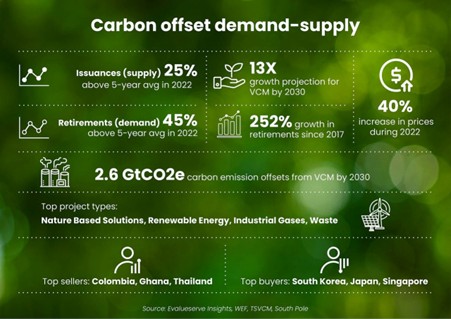Cercarbono’s recent release of its final biodiversity crediting protocol signifies a significant advancement in environmental conservation efforts. This protocol establishes a robust framework for certifying biodiversity credits, providing essential guidelines and standards to ensure the effectiveness and integrity of biodiversity projects worldwide.
The Cercarbono Biodiversity Certification Programme (CBCP) represents a pioneering effort to promote credible quantification, verification, and certification of positive biodiversity outcomes arising from conservation activities. Through the establishment of rigorous criteria and requirements for certifying biodiversity net gains, CBCP seeks to create a framework that enables the verification and certification of these outcomes.
One of the primary objectives of the programme is to unlock new sources of finance for biodiversity conservation efforts globally. By providing a robust methodology for biodiversity crediting and certification, CBCP aims to attract investment from various sources, including public climate funds, corporations, and financial institutions. These investments can then be directed towards on-ground projects that deliver tangible ecosystem service benefits and contribute significantly to global biodiversity goals.
The protocol outlined by CBCP specifies accreditation requirements for issuing Voluntary Biodiversity Credits (VBCs) to Biodiversity Crediting Projects (BCPs). This accreditation process ensures that only projects meeting the highest standards of biodiversity conservation and net gains are eligible to receive VBCs. By setting stringent criteria and ensuring transparent certification processes, CBCP aims to instill confidence among investors and stakeholders regarding the credibility and effectiveness of biodiversity conservation initiatives.
Overall, CBCP plays a crucial role in bridging the gap between conservation efforts and financial support by providing a reliable mechanism for quantifying and certifying biodiversity outcomes. Through its accreditation process, the programme facilitates the flow of investment towards projects that not only deliver measurable biodiversity benefits but also contribute to broader sustainability objectives and global biodiversity targets.
At its core, the protocol underscores the pressing need to address environmental concerns promptly. By prioritizing the expeditious implementation of biodiversity projects, Cercarbono aims to accelerate action towards safeguarding and restoring biodiversity. This emphasis on swift action is crucial in addressing the urgent challenges facing our planet’s ecosystems.
One of the key strengths of the protocol lies in its streamlined processes and clear criteria for project evaluation. By offering clarity and guidance, Cercarbono empowers stakeholders to navigate the complexities of biodiversity conservation with confidence. This, in turn, facilitates more efficient and effective decision-making in the pursuit of environmental sustainability.
Through the adoption of this protocol, stakeholders, including governments, corporations, and conservation organizations, gain access to the tools and resources needed to drive impactful biodiversity conservation efforts. By incentivizing the preservation and restoration of natural habitats, Cercarbono’s initiative plays a pivotal role in mitigating biodiversity loss and promoting the health and resilience of ecosystems worldwide. Ultimately, the protocol represents a crucial step forward in the collective effort to address the interconnected challenges of biodiversity loss and climate change.
The Intergovernmental Science-Policy Platform on Biodiversity and Ecosystem Services (IPBES) and the Convention on Biological Diversity (CBD) have underscored the urgent need for action to conserve biodiversity. Both organizations have highlighted the critical state of global biodiversity, emphasizing the necessity for coordinated efforts to combat the ongoing loss of species and ecosystems. They have also drawn attention to the interconnected synergies between biodiversity loss, climate change, and land degradation.
While carbon markets and emerging biodiversity markets have addressed the need for robust and credible mechanisms to ensure environmental benefits, establishing a robust voluntary carbon market has taken decades of regulatory and methodological development. The biodiversity market is even more complex due to the lack of a standard unit of measurement and the diversity of genetics, species, and ecosystems.
Key issues in the biodiversity market, such as the conservation of pollinators, wild crop varieties, genetics of domestic animal species, and reintroduction of endangered species, must not be overlooked. Establishing a standard unit of measurement and maintaining rigor similar to carbon markets is crucial to address potential negative impacts arising from poor biodiversity management.
The protocol established by Cercarbono aims to address these challenges by providing a certification framework for biodiversity credits, focusing on expeditiously implementing biodiversity projects. It offers precise guidelines on procedures, methodologies, and metrics for a diverse range of biodiversity conservation activities while maintaining flexibility to encourage implementation.
The protocol encompasses various types of interventions, including climate change adaptation and biodiversity conservation, addressing biodiversity at genetic, species, and ecosystem levels across terrestrial, freshwater, wetland, and marine ecosystems. It also considers social and heritage contexts, including indigenous peoples, local communities, and World Heritage sites.
Aligning Biodiversity Crediting Projects (BCPs) with the Sustainable Development Goals (SDGs) and the Kunming-Montreal Global Biodiversity Framework is crucial. Developing a crediting system that allows for a fair comparison of diverse biodiversity-related initiatives is challenging but essential for effectively addressing the biodiversity crisis.
The protocol encourages inclusivity by encompassing a diverse array of biodiversity conservation activities. Projects can propose methodologies for approval when specific credit generation metrics are not defined, ensuring that all activities are accounted for within the program. This comprehensive approach aims to drive meaningful progress towards biodiversity conservation and ecosystem resilience.



